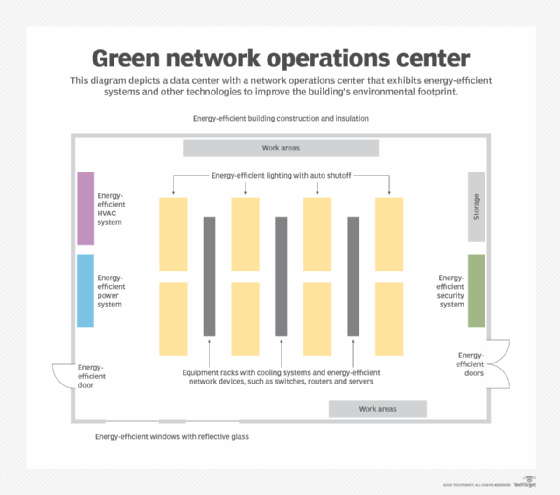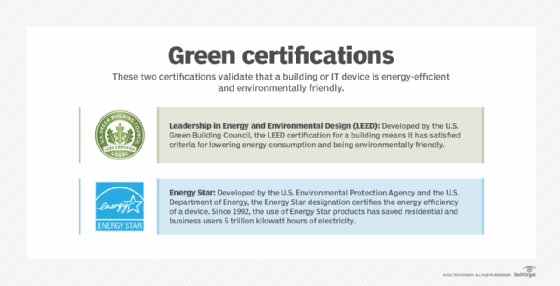green networking
What is green networking?
Green networking is the practice of selecting energy-efficient networking technologies and products and minimizing resource use whenever possible.
Green networking practices include the following:
- updating IT policies to support the use of green technologies and resources;
- increasing the use of off-premises networking, such as cloud services;
- updating office space and data centers to be more energy-efficient;
- implementing network virtualization;
- practicing server consolidation;
- upgrading older equipment for newer, more energy-efficient products;
- employing systems management to increase efficiency;
- substituting remote working, remote administration and video conferencing for travel; and
- organizing periodic reviews by environmental experts to validate green activities.
Although investing in green networking may require an initial cash outlay, the products, services and practices involved typically save money over time.
What is the goal of green networks?
A green data center, which typically houses the nerve center of a company's networking infrastructure, is used for the storage, management and dissemination of data. The physical components of the building structure -- such as environmental systems, security systems, lighting, electrical and computing resources -- are selected and deployed to minimize the environmental impact, while maximizing energy efficiency.
The following is a list of technologies and strategies used in green data centers, which also house network operations centers (NOCs):
- building footprints redesigned to take up less space;
- catalytic converters on backup generators;
- low-emission building materials, carpets and paints;
- energy-efficient window glass;
- entry and exit points that are energy-efficient;
- sustainable landscaping;
- e-waste recycling;
- energy-optimizing systems, such as solar farms, data center evaporative cooling and heat pumps; and
- using hybrid or electric vehicles.
Building and certifying a green data center or other facility that supports green networking operations can be costly upfront. But, over time, savings can be achieved on energy, heating and cooling, networking operations and systems maintenance.
For businesses, the goal of green networks is to cut energy consumption and emissions to help improve air quality and the overall environment. An environmentally clean and friendly organization is also healthy for employees. Local communities may also appreciate green networking facilities.
Another goal of green networks is to address and assuage concerns from environmental groups. Additionally, for organizations that use environmentally responsible technologies, governmental financial incentives may be possible.
What are the approaches to green networking?
At a fundamental level, the configuration of a network infrastructure does not need to change in a green networking environment. The existing configuration doesn't need to change, assuming it provides the services needed, as well as the desired data throughput, latency control and security measures to protect the network and its perimeter from cybersecurity threats.
The principal approach to green networking is to replace existing network components with energy-efficient units. If the building that houses network elements is not being changed to a more environmentally friendly facility, then not much can be done there. Energy-aware organizations that want to be environmentally friendly can deploy energy-efficient units to replace such things as backup power systems, HVAC systems, building security systems and even window glass.
Figure 1 depicts a data center with a green NOC that has energy-efficient systems and other technologies to improve the building's environmental footprint. Many of these energy improvements can be implemented as part of an upgrade to the NOC. For a successful green strategy, an organization's commitment to green networking is essential.

As the bulk of a network infrastructure is often external to an organization, the carriers that provide connectivity should be queried to understand their approach to green technology. Organizations should observe and validate the carriers' green activities in their switching centers and data centers. Reports on energy savings and other environmental metrics should be available for customers to review.
Certain metrics demonstrate and certify that buildings are energy-efficient and minimize damage to the environment. Green networking centers conform to one or both of the following two metrics that measure energy usage and sustainability.
1. Power usage effectiveness
Developed in 1997, power usage effectiveness (PUE) measures the power consumption of a data center. It is the ratio of the power provided to the data center divided by the power that the equipment in the data center uses. The goal is to have the ratio come as close as possible to one, which indicates effective power usage. PUE is a metric used to assess the efficiency of a data center. Networking equipment is among the many components found in data centers. Many networking devices in use -- such as servers, switches, firewalls and routers -- can be found that are environmentally friendly.
2. Carbon usage effectiveness
Carbon usage effectiveness (CUE) is a metric that was developed by The Green Grid, an affiliate member of the Information Technology Industry Council. CUE is the ratio of carbon dioxide emissions that the data center generates divided by the energy consumption of data center equipment. The goal is to have the lowest possible value, which indicates the data center and NOC are effectively controlling carbon dioxide emissions and reducing the carbon footprint.
Green networking certifications
In addition to these metrics, two certifications are available to validate that a building or IT device is energy-efficient and environmentally friendly.
1. Leadership in Energy and Environmental Design
Developed by the U.S. Green Building Council, the Leadership in Energy and Environmental Design, or LEED, certification for a building means it has satisfied criteria for lowering energy consumption and being environmentally friendly.
2. Energy Star
Developed by the U.S. Environmental Protection Agency and the U.S. Department of Energy, the Energy Star designation certifies the energy efficiency of a device. Since 1992, the use of Energy Star products has saved residential and business users 5 trillion kilowatt hours of electricity.

What are the benefits of green networking?
The Storage Networking Industry Association notes that energy consumption is one of the largest budget items of a data center. It's also among the top 10 issues that concern data center operators and, by extension, network operations managers.
By committing to green networking, organizations can reap certain benefits. Specifically, over time, they could see a reduction of the following items: operating costs, electricity consumption, physical space, carbon footprint, carbon emissions, water use and waste output.
What is the difference between green networks and traditional networks?
As noted earlier, the components within a green NOC are energy-efficient as compared to data centers without such operational and environmental controls. To go green, the network configuration does not need to change -- only the physical components.
Another important way to increase the green factor is to migrate network components into a cloud or managed service provider environment. That way, the organization eliminates the need for a physical NOC, as most network management can be handled by dashboards and other administrative tools linked to a network management system.
Considering how cloud service providers have grown in popularity, many of the key providers -- such as Amazon, Microsoft and Google -- are major users of environmentally friendly data centers. Many network service providers, such as local telephone companies, have also instituted green measures in their central offices.







